NRSG366 Case Study: Peter Mitchell, Care Priorities & Interventions
VerifiedAdded on 2023/04/23
|7
|2670
|226
Case Study
AI Summary
This case study focuses on Peter Mitchell, utilizing the clinical reasoning cycle to identify and address his healthcare priorities, primarily hypertension, obesity, and unmanaged diabetes. The analysis highlights the significance of managing Peter's smoking habits through education, medication, and counseling therapies such as cognitive behavioral therapy and nicotine replacement therapy. It further explores the connection between obesity and diabetes, emphasizing the importance of health education, motivational interviewing, and lifestyle interventions, including weight loss programs, dietary changes, and regular exercise. The study also suggests the involvement of counselors and diabetes educators to enhance Peter's self-motivation, confidence, and understanding of blood glucose level control. Regular evaluation processes are essential to monitor progress and adjust interventions as needed, ensuring a better quality of life for Peter. The student reflects on how the clinical reasoning cycle provided a structured framework for analyzing the patient's condition, setting care priorities, and developing effective interventions.

Running head: CASE STUDY OF PETER MITCHELL
CASE STUDY OF PETER MITCHELL
Name of the student:
Name of the university:
Author note:
CASE STUDY OF PETER MITCHELL
Name of the student:
Name of the university:
Author note:
Paraphrase This Document
Need a fresh take? Get an instant paraphrase of this document with our AI Paraphraser
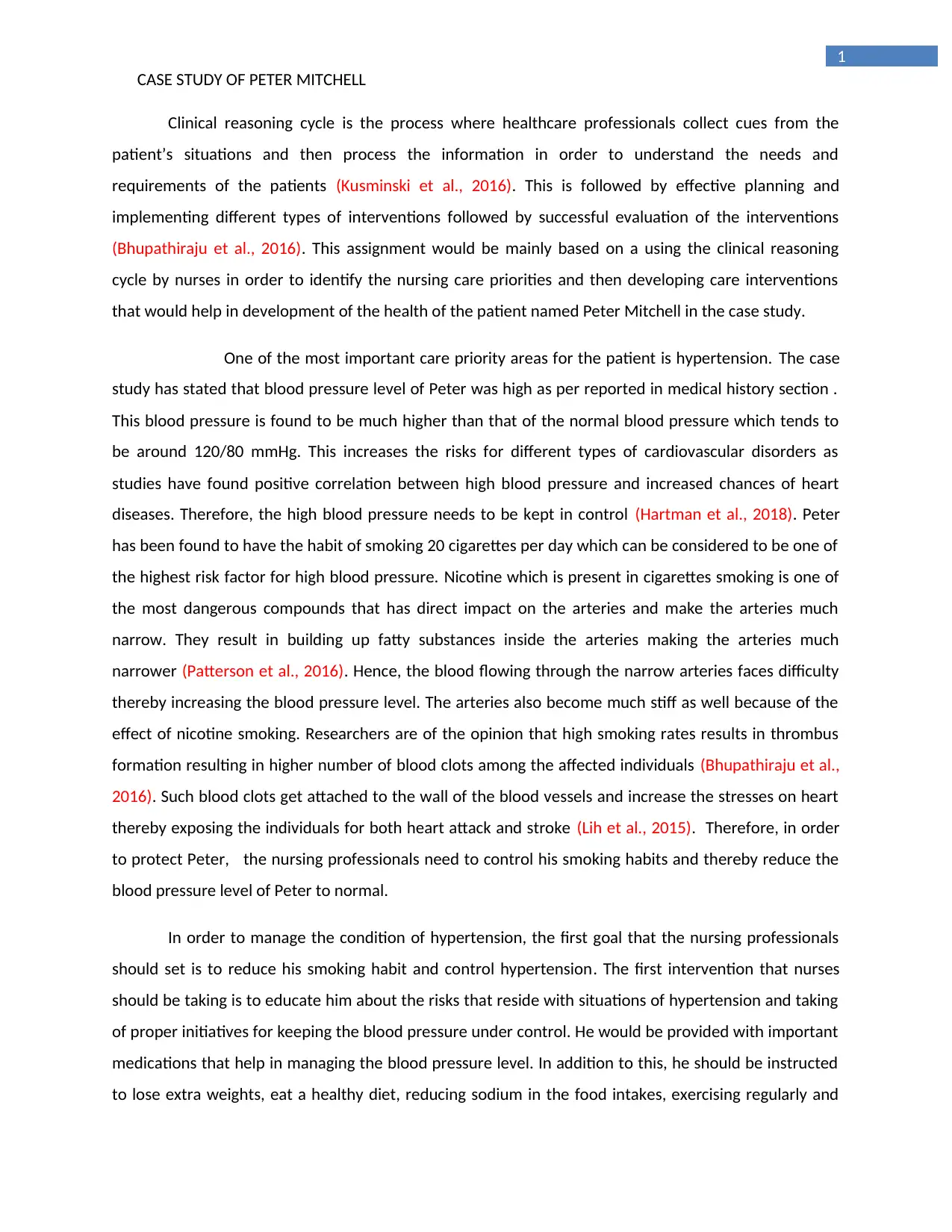
1
CASE STUDY OF PETER MITCHELL
Clinical reasoning cycle is the process where healthcare professionals collect cues from the
patient’s situations and then process the information in order to understand the needs and
requirements of the patients (Kusminski et al., 2016). This is followed by effective planning and
implementing different types of interventions followed by successful evaluation of the interventions
(Bhupathiraju et al., 2016). This assignment would be mainly based on a using the clinical reasoning
cycle by nurses in order to identify the nursing care priorities and then developing care interventions
that would help in development of the health of the patient named Peter Mitchell in the case study.
One of the most important care priority areas for the patient is hypertension. The case
study has stated that blood pressure level of Peter was high as per reported in medical history section .
This blood pressure is found to be much higher than that of the normal blood pressure which tends to
be around 120/80 mmHg. This increases the risks for different types of cardiovascular disorders as
studies have found positive correlation between high blood pressure and increased chances of heart
diseases. Therefore, the high blood pressure needs to be kept in control (Hartman et al., 2018). Peter
has been found to have the habit of smoking 20 cigarettes per day which can be considered to be one of
the highest risk factor for high blood pressure. Nicotine which is present in cigarettes smoking is one of
the most dangerous compounds that has direct impact on the arteries and make the arteries much
narrow. They result in building up fatty substances inside the arteries making the arteries much
narrower (Patterson et al., 2016). Hence, the blood flowing through the narrow arteries faces difficulty
thereby increasing the blood pressure level. The arteries also become much stiff as well because of the
effect of nicotine smoking. Researchers are of the opinion that high smoking rates results in thrombus
formation resulting in higher number of blood clots among the affected individuals (Bhupathiraju et al.,
2016). Such blood clots get attached to the wall of the blood vessels and increase the stresses on heart
thereby exposing the individuals for both heart attack and stroke (Lih et al., 2015). Therefore, in order
to protect Peter, the nursing professionals need to control his smoking habits and thereby reduce the
blood pressure level of Peter to normal.
In order to manage the condition of hypertension, the first goal that the nursing professionals
should set is to reduce his smoking habit and control hypertension. The first intervention that nurses
should be taking is to educate him about the risks that reside with situations of hypertension and taking
of proper initiatives for keeping the blood pressure under control. He would be provided with important
medications that help in managing the blood pressure level. In addition to this, he should be instructed
to lose extra weights, eat a healthy diet, reducing sodium in the food intakes, exercising regularly and
CASE STUDY OF PETER MITCHELL
Clinical reasoning cycle is the process where healthcare professionals collect cues from the
patient’s situations and then process the information in order to understand the needs and
requirements of the patients (Kusminski et al., 2016). This is followed by effective planning and
implementing different types of interventions followed by successful evaluation of the interventions
(Bhupathiraju et al., 2016). This assignment would be mainly based on a using the clinical reasoning
cycle by nurses in order to identify the nursing care priorities and then developing care interventions
that would help in development of the health of the patient named Peter Mitchell in the case study.
One of the most important care priority areas for the patient is hypertension. The case
study has stated that blood pressure level of Peter was high as per reported in medical history section .
This blood pressure is found to be much higher than that of the normal blood pressure which tends to
be around 120/80 mmHg. This increases the risks for different types of cardiovascular disorders as
studies have found positive correlation between high blood pressure and increased chances of heart
diseases. Therefore, the high blood pressure needs to be kept in control (Hartman et al., 2018). Peter
has been found to have the habit of smoking 20 cigarettes per day which can be considered to be one of
the highest risk factor for high blood pressure. Nicotine which is present in cigarettes smoking is one of
the most dangerous compounds that has direct impact on the arteries and make the arteries much
narrow. They result in building up fatty substances inside the arteries making the arteries much
narrower (Patterson et al., 2016). Hence, the blood flowing through the narrow arteries faces difficulty
thereby increasing the blood pressure level. The arteries also become much stiff as well because of the
effect of nicotine smoking. Researchers are of the opinion that high smoking rates results in thrombus
formation resulting in higher number of blood clots among the affected individuals (Bhupathiraju et al.,
2016). Such blood clots get attached to the wall of the blood vessels and increase the stresses on heart
thereby exposing the individuals for both heart attack and stroke (Lih et al., 2015). Therefore, in order
to protect Peter, the nursing professionals need to control his smoking habits and thereby reduce the
blood pressure level of Peter to normal.
In order to manage the condition of hypertension, the first goal that the nursing professionals
should set is to reduce his smoking habit and control hypertension. The first intervention that nurses
should be taking is to educate him about the risks that reside with situations of hypertension and taking
of proper initiatives for keeping the blood pressure under control. He would be provided with important
medications that help in managing the blood pressure level. In addition to this, he should be instructed
to lose extra weights, eat a healthy diet, reducing sodium in the food intakes, exercising regularly and
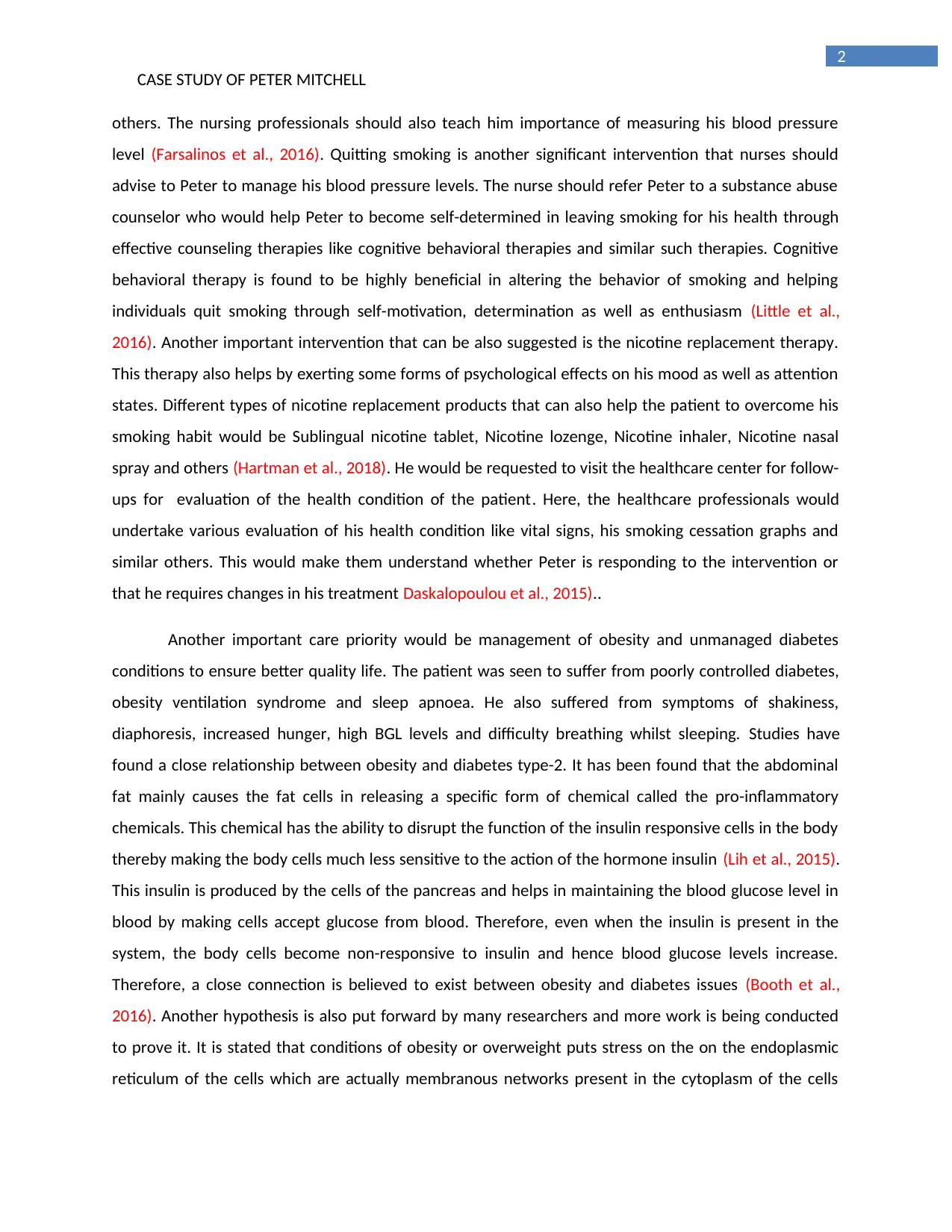
2
CASE STUDY OF PETER MITCHELL
others. The nursing professionals should also teach him importance of measuring his blood pressure
level (Farsalinos et al., 2016). Quitting smoking is another significant intervention that nurses should
advise to Peter to manage his blood pressure levels. The nurse should refer Peter to a substance abuse
counselor who would help Peter to become self-determined in leaving smoking for his health through
effective counseling therapies like cognitive behavioral therapies and similar such therapies. Cognitive
behavioral therapy is found to be highly beneficial in altering the behavior of smoking and helping
individuals quit smoking through self-motivation, determination as well as enthusiasm (Little et al.,
2016). Another important intervention that can be also suggested is the nicotine replacement therapy.
This therapy also helps by exerting some forms of psychological effects on his mood as well as attention
states. Different types of nicotine replacement products that can also help the patient to overcome his
smoking habit would be Sublingual nicotine tablet, Nicotine lozenge, Nicotine inhaler, Nicotine nasal
spray and others (Hartman et al., 2018). He would be requested to visit the healthcare center for follow-
ups for evaluation of the health condition of the patient. Here, the healthcare professionals would
undertake various evaluation of his health condition like vital signs, his smoking cessation graphs and
similar others. This would make them understand whether Peter is responding to the intervention or
that he requires changes in his treatment Daskalopoulou et al., 2015)..
Another important care priority would be management of obesity and unmanaged diabetes
conditions to ensure better quality life. The patient was seen to suffer from poorly controlled diabetes,
obesity ventilation syndrome and sleep apnoea. He also suffered from symptoms of shakiness,
diaphoresis, increased hunger, high BGL levels and difficulty breathing whilst sleeping. Studies have
found a close relationship between obesity and diabetes type-2. It has been found that the abdominal
fat mainly causes the fat cells in releasing a specific form of chemical called the pro-inflammatory
chemicals. This chemical has the ability to disrupt the function of the insulin responsive cells in the body
thereby making the body cells much less sensitive to the action of the hormone insulin (Lih et al., 2015).
This insulin is produced by the cells of the pancreas and helps in maintaining the blood glucose level in
blood by making cells accept glucose from blood. Therefore, even when the insulin is present in the
system, the body cells become non-responsive to insulin and hence blood glucose levels increase.
Therefore, a close connection is believed to exist between obesity and diabetes issues (Booth et al.,
2016). Another hypothesis is also put forward by many researchers and more work is being conducted
to prove it. It is stated that conditions of obesity or overweight puts stress on the on the endoplasmic
reticulum of the cells which are actually membranous networks present in the cytoplasm of the cells
CASE STUDY OF PETER MITCHELL
others. The nursing professionals should also teach him importance of measuring his blood pressure
level (Farsalinos et al., 2016). Quitting smoking is another significant intervention that nurses should
advise to Peter to manage his blood pressure levels. The nurse should refer Peter to a substance abuse
counselor who would help Peter to become self-determined in leaving smoking for his health through
effective counseling therapies like cognitive behavioral therapies and similar such therapies. Cognitive
behavioral therapy is found to be highly beneficial in altering the behavior of smoking and helping
individuals quit smoking through self-motivation, determination as well as enthusiasm (Little et al.,
2016). Another important intervention that can be also suggested is the nicotine replacement therapy.
This therapy also helps by exerting some forms of psychological effects on his mood as well as attention
states. Different types of nicotine replacement products that can also help the patient to overcome his
smoking habit would be Sublingual nicotine tablet, Nicotine lozenge, Nicotine inhaler, Nicotine nasal
spray and others (Hartman et al., 2018). He would be requested to visit the healthcare center for follow-
ups for evaluation of the health condition of the patient. Here, the healthcare professionals would
undertake various evaluation of his health condition like vital signs, his smoking cessation graphs and
similar others. This would make them understand whether Peter is responding to the intervention or
that he requires changes in his treatment Daskalopoulou et al., 2015)..
Another important care priority would be management of obesity and unmanaged diabetes
conditions to ensure better quality life. The patient was seen to suffer from poorly controlled diabetes,
obesity ventilation syndrome and sleep apnoea. He also suffered from symptoms of shakiness,
diaphoresis, increased hunger, high BGL levels and difficulty breathing whilst sleeping. Studies have
found a close relationship between obesity and diabetes type-2. It has been found that the abdominal
fat mainly causes the fat cells in releasing a specific form of chemical called the pro-inflammatory
chemicals. This chemical has the ability to disrupt the function of the insulin responsive cells in the body
thereby making the body cells much less sensitive to the action of the hormone insulin (Lih et al., 2015).
This insulin is produced by the cells of the pancreas and helps in maintaining the blood glucose level in
blood by making cells accept glucose from blood. Therefore, even when the insulin is present in the
system, the body cells become non-responsive to insulin and hence blood glucose levels increase.
Therefore, a close connection is believed to exist between obesity and diabetes issues (Booth et al.,
2016). Another hypothesis is also put forward by many researchers and more work is being conducted
to prove it. It is stated that conditions of obesity or overweight puts stress on the on the endoplasmic
reticulum of the cells which are actually membranous networks present in the cytoplasm of the cells
⊘ This is a preview!⊘
Do you want full access?
Subscribe today to unlock all pages.

Trusted by 1+ million students worldwide
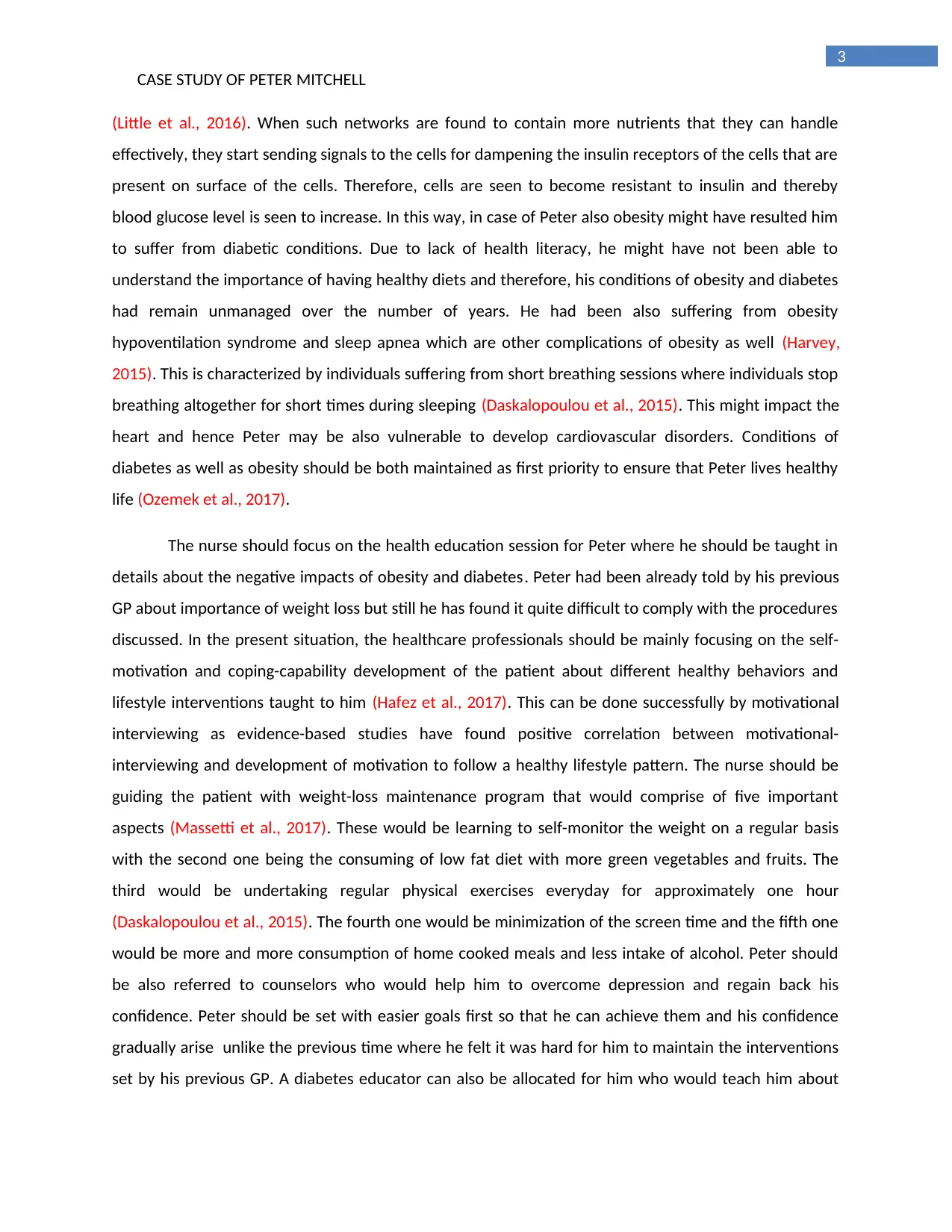
3
CASE STUDY OF PETER MITCHELL
(Little et al., 2016). When such networks are found to contain more nutrients that they can handle
effectively, they start sending signals to the cells for dampening the insulin receptors of the cells that are
present on surface of the cells. Therefore, cells are seen to become resistant to insulin and thereby
blood glucose level is seen to increase. In this way, in case of Peter also obesity might have resulted him
to suffer from diabetic conditions. Due to lack of health literacy, he might have not been able to
understand the importance of having healthy diets and therefore, his conditions of obesity and diabetes
had remain unmanaged over the number of years. He had been also suffering from obesity
hypoventilation syndrome and sleep apnea which are other complications of obesity as well (Harvey,
2015). This is characterized by individuals suffering from short breathing sessions where individuals stop
breathing altogether for short times during sleeping (Daskalopoulou et al., 2015). This might impact the
heart and hence Peter may be also vulnerable to develop cardiovascular disorders. Conditions of
diabetes as well as obesity should be both maintained as first priority to ensure that Peter lives healthy
life (Ozemek et al., 2017).
The nurse should focus on the health education session for Peter where he should be taught in
details about the negative impacts of obesity and diabetes. Peter had been already told by his previous
GP about importance of weight loss but still he has found it quite difficult to comply with the procedures
discussed. In the present situation, the healthcare professionals should be mainly focusing on the self-
motivation and coping-capability development of the patient about different healthy behaviors and
lifestyle interventions taught to him (Hafez et al., 2017). This can be done successfully by motivational
interviewing as evidence-based studies have found positive correlation between motivational-
interviewing and development of motivation to follow a healthy lifestyle pattern. The nurse should be
guiding the patient with weight-loss maintenance program that would comprise of five important
aspects (Massetti et al., 2017). These would be learning to self-monitor the weight on a regular basis
with the second one being the consuming of low fat diet with more green vegetables and fruits. The
third would be undertaking regular physical exercises everyday for approximately one hour
(Daskalopoulou et al., 2015). The fourth one would be minimization of the screen time and the fifth one
would be more and more consumption of home cooked meals and less intake of alcohol. Peter should
be also referred to counselors who would help him to overcome depression and regain back his
confidence. Peter should be set with easier goals first so that he can achieve them and his confidence
gradually arise unlike the previous time where he felt it was hard for him to maintain the interventions
set by his previous GP. A diabetes educator can also be allocated for him who would teach him about
CASE STUDY OF PETER MITCHELL
(Little et al., 2016). When such networks are found to contain more nutrients that they can handle
effectively, they start sending signals to the cells for dampening the insulin receptors of the cells that are
present on surface of the cells. Therefore, cells are seen to become resistant to insulin and thereby
blood glucose level is seen to increase. In this way, in case of Peter also obesity might have resulted him
to suffer from diabetic conditions. Due to lack of health literacy, he might have not been able to
understand the importance of having healthy diets and therefore, his conditions of obesity and diabetes
had remain unmanaged over the number of years. He had been also suffering from obesity
hypoventilation syndrome and sleep apnea which are other complications of obesity as well (Harvey,
2015). This is characterized by individuals suffering from short breathing sessions where individuals stop
breathing altogether for short times during sleeping (Daskalopoulou et al., 2015). This might impact the
heart and hence Peter may be also vulnerable to develop cardiovascular disorders. Conditions of
diabetes as well as obesity should be both maintained as first priority to ensure that Peter lives healthy
life (Ozemek et al., 2017).
The nurse should focus on the health education session for Peter where he should be taught in
details about the negative impacts of obesity and diabetes. Peter had been already told by his previous
GP about importance of weight loss but still he has found it quite difficult to comply with the procedures
discussed. In the present situation, the healthcare professionals should be mainly focusing on the self-
motivation and coping-capability development of the patient about different healthy behaviors and
lifestyle interventions taught to him (Hafez et al., 2017). This can be done successfully by motivational
interviewing as evidence-based studies have found positive correlation between motivational-
interviewing and development of motivation to follow a healthy lifestyle pattern. The nurse should be
guiding the patient with weight-loss maintenance program that would comprise of five important
aspects (Massetti et al., 2017). These would be learning to self-monitor the weight on a regular basis
with the second one being the consuming of low fat diet with more green vegetables and fruits. The
third would be undertaking regular physical exercises everyday for approximately one hour
(Daskalopoulou et al., 2015). The fourth one would be minimization of the screen time and the fifth one
would be more and more consumption of home cooked meals and less intake of alcohol. Peter should
be also referred to counselors who would help him to overcome depression and regain back his
confidence. Peter should be set with easier goals first so that he can achieve them and his confidence
gradually arise unlike the previous time where he felt it was hard for him to maintain the interventions
set by his previous GP. A diabetes educator can also be allocated for him who would teach him about
Paraphrase This Document
Need a fresh take? Get an instant paraphrase of this document with our AI Paraphraser
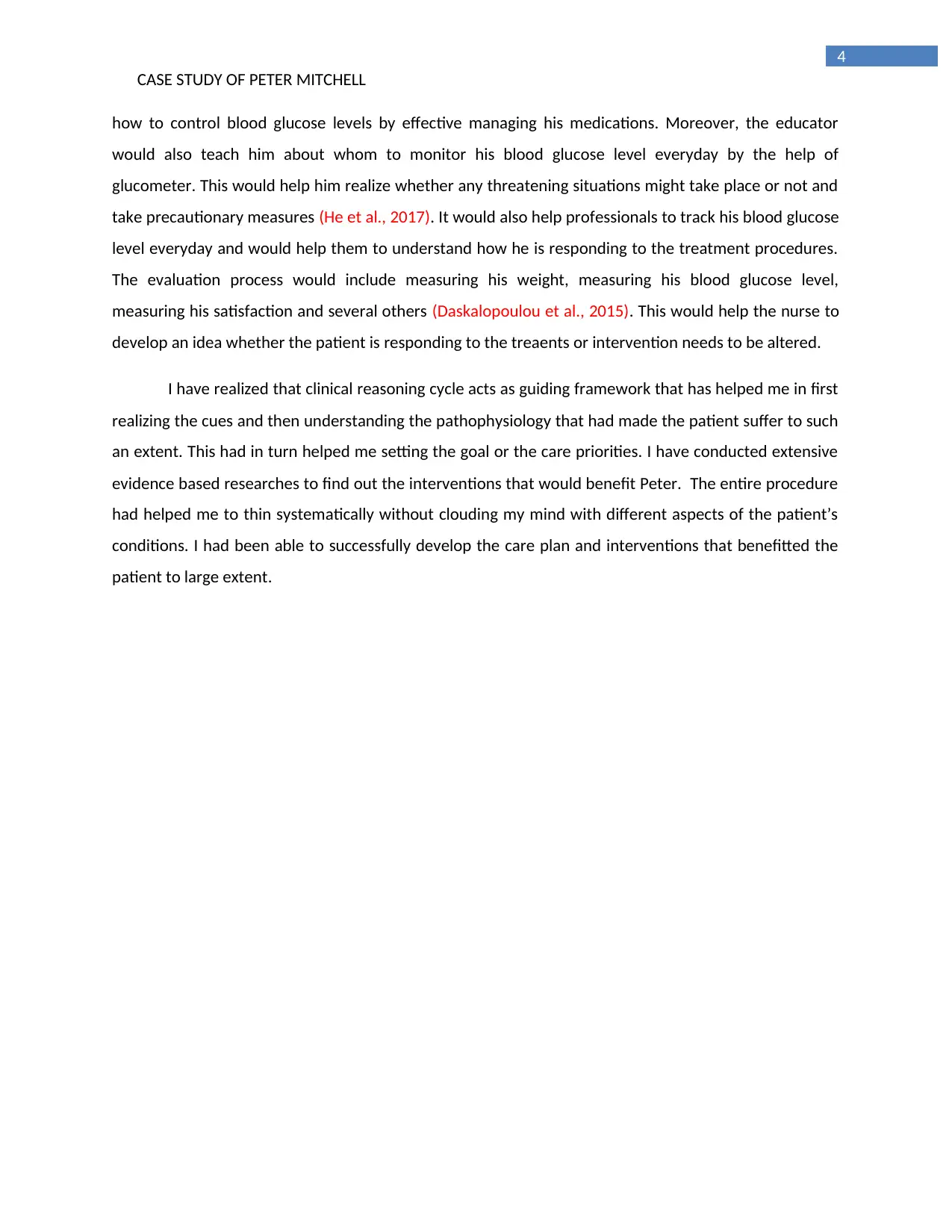
4
CASE STUDY OF PETER MITCHELL
how to control blood glucose levels by effective managing his medications. Moreover, the educator
would also teach him about whom to monitor his blood glucose level everyday by the help of
glucometer. This would help him realize whether any threatening situations might take place or not and
take precautionary measures (He et al., 2017). It would also help professionals to track his blood glucose
level everyday and would help them to understand how he is responding to the treatment procedures.
The evaluation process would include measuring his weight, measuring his blood glucose level,
measuring his satisfaction and several others (Daskalopoulou et al., 2015). This would help the nurse to
develop an idea whether the patient is responding to the treaents or intervention needs to be altered.
I have realized that clinical reasoning cycle acts as guiding framework that has helped me in first
realizing the cues and then understanding the pathophysiology that had made the patient suffer to such
an extent. This had in turn helped me setting the goal or the care priorities. I have conducted extensive
evidence based researches to find out the interventions that would benefit Peter. The entire procedure
had helped me to thin systematically without clouding my mind with different aspects of the patient’s
conditions. I had been able to successfully develop the care plan and interventions that benefitted the
patient to large extent.
CASE STUDY OF PETER MITCHELL
how to control blood glucose levels by effective managing his medications. Moreover, the educator
would also teach him about whom to monitor his blood glucose level everyday by the help of
glucometer. This would help him realize whether any threatening situations might take place or not and
take precautionary measures (He et al., 2017). It would also help professionals to track his blood glucose
level everyday and would help them to understand how he is responding to the treatment procedures.
The evaluation process would include measuring his weight, measuring his blood glucose level,
measuring his satisfaction and several others (Daskalopoulou et al., 2015). This would help the nurse to
develop an idea whether the patient is responding to the treaents or intervention needs to be altered.
I have realized that clinical reasoning cycle acts as guiding framework that has helped me in first
realizing the cues and then understanding the pathophysiology that had made the patient suffer to such
an extent. This had in turn helped me setting the goal or the care priorities. I have conducted extensive
evidence based researches to find out the interventions that would benefit Peter. The entire procedure
had helped me to thin systematically without clouding my mind with different aspects of the patient’s
conditions. I had been able to successfully develop the care plan and interventions that benefitted the
patient to large extent.
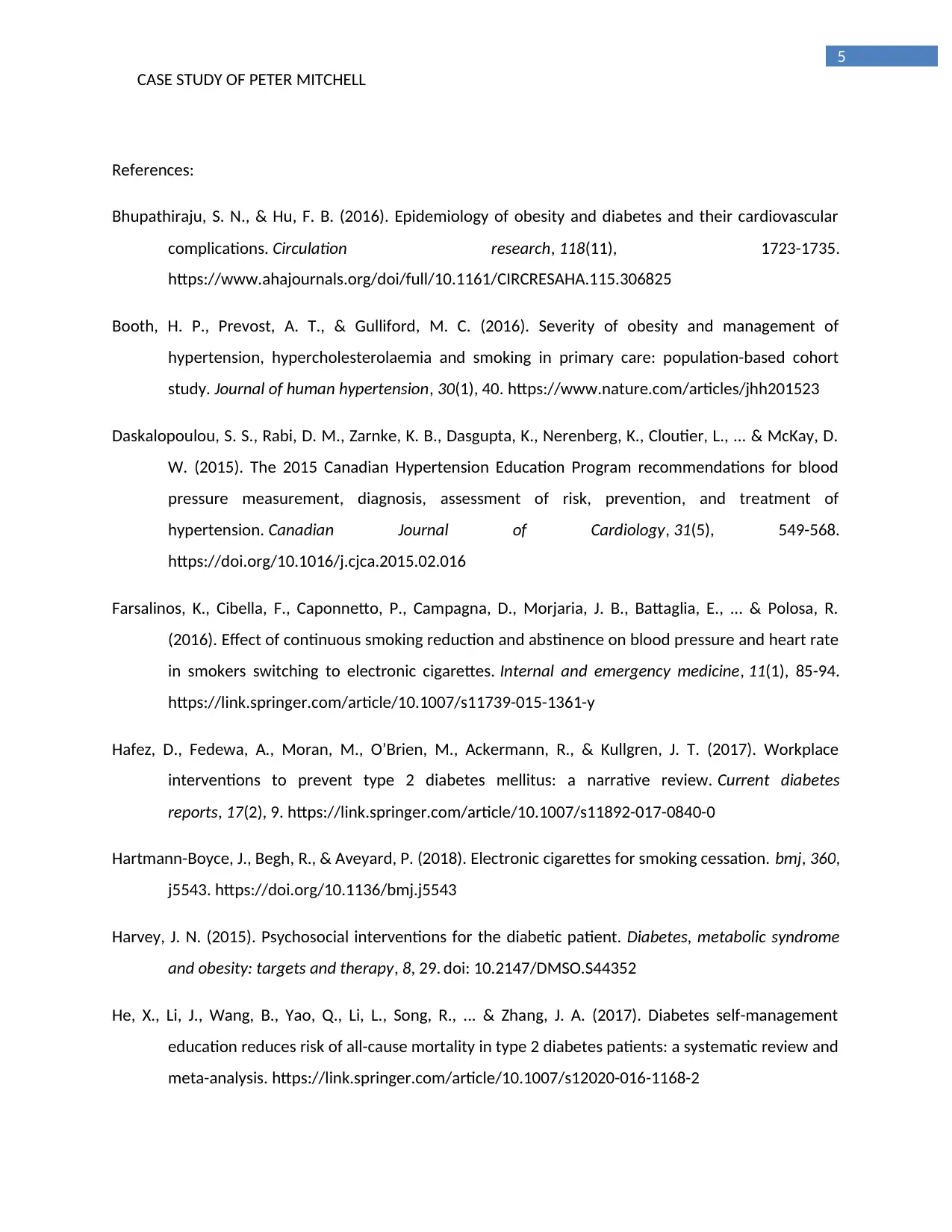
5
CASE STUDY OF PETER MITCHELL
References:
Bhupathiraju, S. N., & Hu, F. B. (2016). Epidemiology of obesity and diabetes and their cardiovascular
complications. Circulation research, 118(11), 1723-1735.
https://www.ahajournals.org/doi/full/10.1161/CIRCRESAHA.115.306825
Booth, H. P., Prevost, A. T., & Gulliford, M. C. (2016). Severity of obesity and management of
hypertension, hypercholesterolaemia and smoking in primary care: population-based cohort
study. Journal of human hypertension, 30(1), 40. https://www.nature.com/articles/jhh201523
Daskalopoulou, S. S., Rabi, D. M., Zarnke, K. B., Dasgupta, K., Nerenberg, K., Cloutier, L., ... & McKay, D.
W. (2015). The 2015 Canadian Hypertension Education Program recommendations for blood
pressure measurement, diagnosis, assessment of risk, prevention, and treatment of
hypertension. Canadian Journal of Cardiology, 31(5), 549-568.
https://doi.org/10.1016/j.cjca.2015.02.016
Farsalinos, K., Cibella, F., Caponnetto, P., Campagna, D., Morjaria, J. B., Battaglia, E., ... & Polosa, R.
(2016). Effect of continuous smoking reduction and abstinence on blood pressure and heart rate
in smokers switching to electronic cigarettes. Internal and emergency medicine, 11(1), 85-94.
https://link.springer.com/article/10.1007/s11739-015-1361-y
Hafez, D., Fedewa, A., Moran, M., O’Brien, M., Ackermann, R., & Kullgren, J. T. (2017). Workplace
interventions to prevent type 2 diabetes mellitus: a narrative review. Current diabetes
reports, 17(2), 9. https://link.springer.com/article/10.1007/s11892-017-0840-0
Hartmann-Boyce, J., Begh, R., & Aveyard, P. (2018). Electronic cigarettes for smoking cessation. bmj, 360,
j5543. https://doi.org/10.1136/bmj.j5543
Harvey, J. N. (2015). Psychosocial interventions for the diabetic patient. Diabetes, metabolic syndrome
and obesity: targets and therapy, 8, 29. doi: 10.2147/DMSO.S44352
He, X., Li, J., Wang, B., Yao, Q., Li, L., Song, R., ... & Zhang, J. A. (2017). Diabetes self-management
education reduces risk of all-cause mortality in type 2 diabetes patients: a systematic review and
meta-analysis. https://link.springer.com/article/10.1007/s12020-016-1168-2
CASE STUDY OF PETER MITCHELL
References:
Bhupathiraju, S. N., & Hu, F. B. (2016). Epidemiology of obesity and diabetes and their cardiovascular
complications. Circulation research, 118(11), 1723-1735.
https://www.ahajournals.org/doi/full/10.1161/CIRCRESAHA.115.306825
Booth, H. P., Prevost, A. T., & Gulliford, M. C. (2016). Severity of obesity and management of
hypertension, hypercholesterolaemia and smoking in primary care: population-based cohort
study. Journal of human hypertension, 30(1), 40. https://www.nature.com/articles/jhh201523
Daskalopoulou, S. S., Rabi, D. M., Zarnke, K. B., Dasgupta, K., Nerenberg, K., Cloutier, L., ... & McKay, D.
W. (2015). The 2015 Canadian Hypertension Education Program recommendations for blood
pressure measurement, diagnosis, assessment of risk, prevention, and treatment of
hypertension. Canadian Journal of Cardiology, 31(5), 549-568.
https://doi.org/10.1016/j.cjca.2015.02.016
Farsalinos, K., Cibella, F., Caponnetto, P., Campagna, D., Morjaria, J. B., Battaglia, E., ... & Polosa, R.
(2016). Effect of continuous smoking reduction and abstinence on blood pressure and heart rate
in smokers switching to electronic cigarettes. Internal and emergency medicine, 11(1), 85-94.
https://link.springer.com/article/10.1007/s11739-015-1361-y
Hafez, D., Fedewa, A., Moran, M., O’Brien, M., Ackermann, R., & Kullgren, J. T. (2017). Workplace
interventions to prevent type 2 diabetes mellitus: a narrative review. Current diabetes
reports, 17(2), 9. https://link.springer.com/article/10.1007/s11892-017-0840-0
Hartmann-Boyce, J., Begh, R., & Aveyard, P. (2018). Electronic cigarettes for smoking cessation. bmj, 360,
j5543. https://doi.org/10.1136/bmj.j5543
Harvey, J. N. (2015). Psychosocial interventions for the diabetic patient. Diabetes, metabolic syndrome
and obesity: targets and therapy, 8, 29. doi: 10.2147/DMSO.S44352
He, X., Li, J., Wang, B., Yao, Q., Li, L., Song, R., ... & Zhang, J. A. (2017). Diabetes self-management
education reduces risk of all-cause mortality in type 2 diabetes patients: a systematic review and
meta-analysis. https://link.springer.com/article/10.1007/s12020-016-1168-2
⊘ This is a preview!⊘
Do you want full access?
Subscribe today to unlock all pages.

Trusted by 1+ million students worldwide
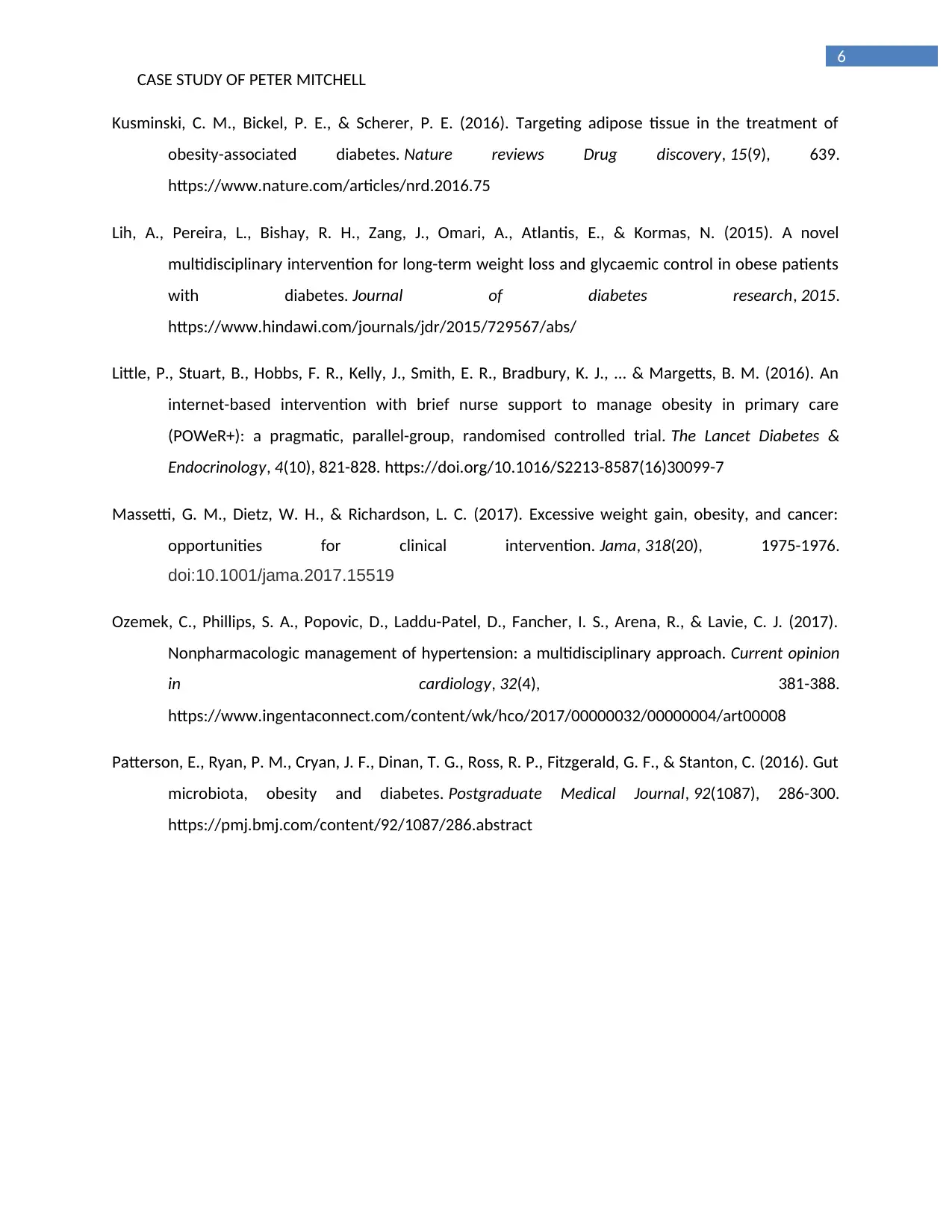
6
CASE STUDY OF PETER MITCHELL
Kusminski, C. M., Bickel, P. E., & Scherer, P. E. (2016). Targeting adipose tissue in the treatment of
obesity-associated diabetes. Nature reviews Drug discovery, 15(9), 639.
https://www.nature.com/articles/nrd.2016.75
Lih, A., Pereira, L., Bishay, R. H., Zang, J., Omari, A., Atlantis, E., & Kormas, N. (2015). A novel
multidisciplinary intervention for long-term weight loss and glycaemic control in obese patients
with diabetes. Journal of diabetes research, 2015.
https://www.hindawi.com/journals/jdr/2015/729567/abs/
Little, P., Stuart, B., Hobbs, F. R., Kelly, J., Smith, E. R., Bradbury, K. J., ... & Margetts, B. M. (2016). An
internet-based intervention with brief nurse support to manage obesity in primary care
(POWeR+): a pragmatic, parallel-group, randomised controlled trial. The Lancet Diabetes &
Endocrinology, 4(10), 821-828. https://doi.org/10.1016/S2213-8587(16)30099-7
Massetti, G. M., Dietz, W. H., & Richardson, L. C. (2017). Excessive weight gain, obesity, and cancer:
opportunities for clinical intervention. Jama, 318(20), 1975-1976.
doi:10.1001/jama.2017.15519
Ozemek, C., Phillips, S. A., Popovic, D., Laddu-Patel, D., Fancher, I. S., Arena, R., & Lavie, C. J. (2017).
Nonpharmacologic management of hypertension: a multidisciplinary approach. Current opinion
in cardiology, 32(4), 381-388.
https://www.ingentaconnect.com/content/wk/hco/2017/00000032/00000004/art00008
Patterson, E., Ryan, P. M., Cryan, J. F., Dinan, T. G., Ross, R. P., Fitzgerald, G. F., & Stanton, C. (2016). Gut
microbiota, obesity and diabetes. Postgraduate Medical Journal, 92(1087), 286-300.
https://pmj.bmj.com/content/92/1087/286.abstract
CASE STUDY OF PETER MITCHELL
Kusminski, C. M., Bickel, P. E., & Scherer, P. E. (2016). Targeting adipose tissue in the treatment of
obesity-associated diabetes. Nature reviews Drug discovery, 15(9), 639.
https://www.nature.com/articles/nrd.2016.75
Lih, A., Pereira, L., Bishay, R. H., Zang, J., Omari, A., Atlantis, E., & Kormas, N. (2015). A novel
multidisciplinary intervention for long-term weight loss and glycaemic control in obese patients
with diabetes. Journal of diabetes research, 2015.
https://www.hindawi.com/journals/jdr/2015/729567/abs/
Little, P., Stuart, B., Hobbs, F. R., Kelly, J., Smith, E. R., Bradbury, K. J., ... & Margetts, B. M. (2016). An
internet-based intervention with brief nurse support to manage obesity in primary care
(POWeR+): a pragmatic, parallel-group, randomised controlled trial. The Lancet Diabetes &
Endocrinology, 4(10), 821-828. https://doi.org/10.1016/S2213-8587(16)30099-7
Massetti, G. M., Dietz, W. H., & Richardson, L. C. (2017). Excessive weight gain, obesity, and cancer:
opportunities for clinical intervention. Jama, 318(20), 1975-1976.
doi:10.1001/jama.2017.15519
Ozemek, C., Phillips, S. A., Popovic, D., Laddu-Patel, D., Fancher, I. S., Arena, R., & Lavie, C. J. (2017).
Nonpharmacologic management of hypertension: a multidisciplinary approach. Current opinion
in cardiology, 32(4), 381-388.
https://www.ingentaconnect.com/content/wk/hco/2017/00000032/00000004/art00008
Patterson, E., Ryan, P. M., Cryan, J. F., Dinan, T. G., Ross, R. P., Fitzgerald, G. F., & Stanton, C. (2016). Gut
microbiota, obesity and diabetes. Postgraduate Medical Journal, 92(1087), 286-300.
https://pmj.bmj.com/content/92/1087/286.abstract
1 out of 7
Related Documents
Your All-in-One AI-Powered Toolkit for Academic Success.
+13062052269
info@desklib.com
Available 24*7 on WhatsApp / Email
![[object Object]](/_next/static/media/star-bottom.7253800d.svg)
Unlock your academic potential
Copyright © 2020–2025 A2Z Services. All Rights Reserved. Developed and managed by ZUCOL.




